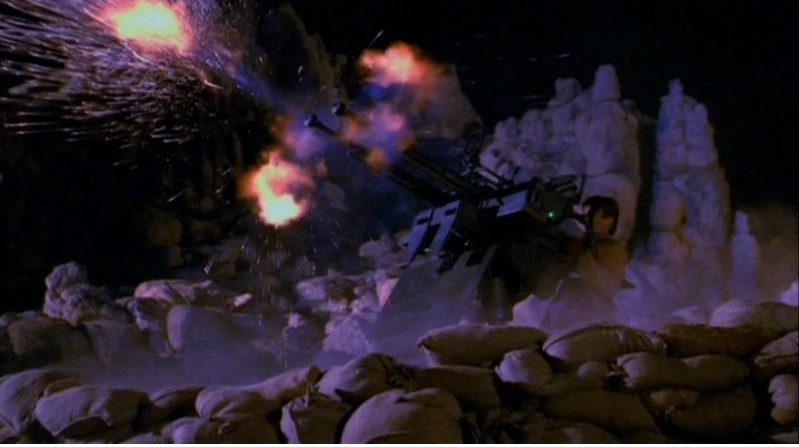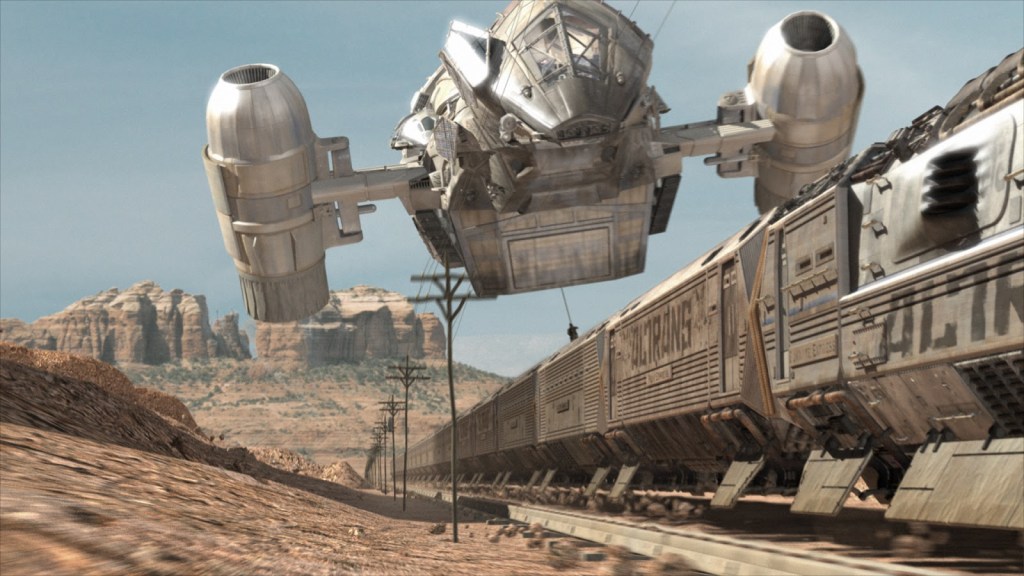“We have done the impossible, and that makes us mighty” – Mal Reynolds
The TV junkyard is littered with dozens if not hundreds of gems that are shows that were killed off too early by dim-witted TV executives. Everyone’s got a favorite show that they loved but apparently no one else did, hence the quick cancellation. Firefly is a prime example. But unlike many of these forgotten gems, Firefly continues to shine 20 years after its debut on television.

Created by Joss Whedon, the man behind the Buffy the Vampire Slayer, Angel and of course, the first two Avengers films, Firefly premiered in the 2002 fall schedule on Fox and was quickly canceled after only fourteen episodes were filmed (fifteen if you count the original pilot episode “Serenity” as a two-part show). In fact, not even all the episodes were aired. But the show found a new life after cancellation in the world of home media. Word of mouth quickly spread and a cult following not seen since Star Trek blossomed.
For the uninitiated the show is basically a science fiction western taking place in 2517, showcasing a group of renegades and smugglers who eke out an existence on board a Firefly-class space freighter called the Serenity. This is the back story; humanity has used up Earth’s resources sometime in the future. Eventually, people abandoned Earth, traveled to another solar system and terraformed dozens of planets and moons to make them habitable. Now the original terraformed planets are the Core Planets and have the latest in technology and resources and are considered the center of the universe or ‘verse as said in the show. The outer planets in the system are known as the Border Planets or Outer Planets and don’t have access to the latest technologies. The people living there are left to fend for themselves with basic tools. In these backwater worlds, the highest level of technology is on the level of the nineteenth century with horses being the common mode of transport. This is why the show has that dusty and rustic Western look. Basically, the show is set in an interplanetary society of haves and have nots.

In the pilot’s opening scenes, viewers witnessed a brutal battle in the civil war between the Alliance (the main governing body of the Core Planets) and the Independents, which was comprised of the Outer Planets. The Alliance won the aforementioned Battle of Serenity Valley and the war. During that battle the show introduced one of the soldiers who fought for the Independents, Malcolm “Mal” Reynolds (Nathan Fillion). According to interviews, Whedon stated that this was an allegory to the American Civil War with the main characters standing in for former Confederate soldiers.
Several years later and now a jaded cynic, Mal owns a beat-up freighter ship that he uses for smuggling operations. His crew is comprised of loyal first mate Zoë Alleyne (Gina Torres), another Independent war veteran; carefree pilot Hoban “Wash” Washburne (Alan Tudyk), who is married to Zoë and loves Hawaiian shirts, dinosaur figures and his wife; Kaylee Frye (Jewel Staite), the whimsical ship’s mechanic and Jayne Cobb (Adam Baldwin) a greedy and not-too-bright muscle man. The rest of the cast are the passengers on board the ship for various reasons. Inara Serra (Morena Baccarin) is a beautiful and cultured prostitute who rents a small shuttle on board and is attracted to Mal and vice versa. Their unrequited romantic tension was a major sub-plot. Reverend Book (Ron Glass) is a spiritual wanderer with a mysterious past with hinted ties to the Alliance. The final two passengers provided much of Firefly’s conflict; Simon (Sean Maher) and River Tam (Summer Glau), two sibling fugitives on the run. River was a gifted student who was forced to undergo deadly experiments by the Alliance and became a deadly psychic killing machine masked under the guise of a gentle and mildly mentally challenged teenage girl. Her brother Simon, a successful rich doctor, risked everything (including his wealth) to free her from the Alliance. In the pilot, Mal decided to allow them to remain on board, provided Simon took a job as the ship’s medic, and kept an eye on her.
Throughout the series, they faced dangers in the form of cannibalistic savages called Reavers, other smugglers, criminals, the unscrupulous upper class and the Alliance itself. The stories were usually about capers and the mishaps they would get into. They were well written with witty dialogue that had an interesting touch; the characters would often speak Mandarin. Whedon surmised that in the future both western and American culture will blend with Asian cultures and great pains are taken to show this in the series. Signs and view screens show Asian and English script, while many crowd scenes had a multicultural ambiance with people wearing outfits influenced by various cultures.

Needless to say the production values were superb, as were the special effects. The pilot episode won an Emmy for best special effects. Many other aspects enabled Firefly to stand out from standard science fiction shows. For instance, during space scenes there was no sound. One cliché that has worn out its welcome is the roaring noise of spaceships in empty space. Anyone who knows a bit of science knows this is impossible since sound cannot travel in the vacuum of space. Instead music, via fiddles and guitars, suggesting a country western motif, was used for dramatic effect in space scenes. Genuine risks involved with living in space were shown. In the episode “Out of Gas” the crew is endangered when a minor component breaks in the ship’s engine causing the air to leak out and life support to break down. In shows like Star Trek and Stargate this dilemma was only spoken about. Here viewers actually saw what happened, the ship grew cold, people had to conserve air. It really was living on the edge. This dedication to being more scientifically realistic was something that The Expanse ran with years later. There weren’t any aliens to be seen; this was a futuristic show set in space that didn’t feature humans in prosthetic makeup. Humanity in the form of crime lords, amoral town bosses, callous government agents and corporate mercenaries were effective villains. No androids either by the way.
But perhaps the most important reason that Firefly was so endearing were the characters themselves. They had many nuanced layers and ambiguities, which were best presented in the episode “Objects in Space” as River psychically picked up on her crewmates’ inner thoughts. Some were just as likely to turn on the others for greed or jealousy. One minute they would say something funny, the next they would show a wicked menacing level. Viewers found themselves rooting for the rogues when they faced the snooty socialites in “Shindig” or “Trash.” It was class warfare in the future and anyone can relate to this.

Why did Fox kill this brilliant show? Poor ratings were the usual culprit, but the network shares the blame. Apparently executives weren’t happy with the show because they didn’t understand it according to some reports. They didn’t like the pilot and forced Whedon to abruptly film a new one (a standard robbery yarn called “The Train Job” which isn’t well regarded and probably chased away potential viewers). The original airing of “The Train Job” broke up the narrative flow in the series. Although not arc-driven, there was a sequential order with the show that careful viewers would pick up on and seeing it out of order can be confusing for some. Strangely, the original pilot, which served as the origin story for the show’s background and characters, turned out to be the last episode aired by Fox before they yanked it in December of 2002.
In spite of these obstacles, Firefly managed to find its audience after it was cancelled, even now 20 years later. Fans, known as browncoats after Mal’s military attire, consider it to be one of the finest science fiction shows ever made. Anyone who gives the show a try will see the foundation of what could’ve been an even more multi-layered series with fully realized characters. At least, audiences got a tempting sampling of this rich ‘verse.

The browncoats, however, did get a bone thrown at them. In 2005, Universal Pictures released the film Serenity, a follow-up to Firefly that reunited all the actors from the series. Written and directed by Whedon, it tied up many loose ends and still left many wanting more. Unfortunately, the film was a dismal failure, scurrying any hopes for a sequel. Yet with strong sales for the Firefly DVD, home media demand, and success with other media such as video games, books, and a currently publishing comic book series, interest in the show still percolates after the creators and actors went their separate ways. They have admitted their fondness for Firefly. There was even an online effort by fans to buy the rights to the show in order to get it revived, but Whedon and others asked for this to cease.
There are constant rumors of some kind of revival but who knows if that will happen? It is always possible for 20th Century Studios or its owners Disney to decide to revisit the ‘verse, but it will have to be without some of the original people. For instance, Ron Glass passed away a few years ago, and Joss Whedon has become a pariah in Hollywood over his behavior during productions. But would a revival work today? It would depend on who would be involved and it most certainly would have to include Nathan Fillion, who was the heart of Firefly. For now all we can do is rewatch Firefly and enjoy the books and other media 20 years after that special gem of show introduced us to the ‘verse.
José Soto



Firefly is one of the Sci-Fi gems that sadly got cancelled before its time. Still, it was great while it lasted. It was a superb show and the effects were stunning as well.
The show was so unique for its time (and still is), it was a shame the network mishandled it and did not give it a chance to to find its audience. Still, at least we fans have these few episodes to cherish, and the film as well.
I pretend that Serenity doesn’t exist because of what happens. You can cancel the series, but you can’t take the sky from me.
Shhh no Serenity spoilers! The film had a different more generic vibe than the show which is ours forever. But the film can also be seen as a finale for the characters and the overall situation with the ‘verse, but those who haven’t seen it should proceed with caution.
Serenity was actually my intro to the Firefly universe and, hopefully without spoiling anything, I thought it was a pretty good one. Of all the efforts for sci-fi TV to broaden the space-age future genre at the time beyond the Star Trek universe, Firefly was one of the most interesting attempts and certainly with Joss Whedon’s creativity. It’s good that the truest of sci-fi fans, as they have with others such shows like Dark Matter, can always show their support when networks fail to recognize what serves the audiences best. Thank you for your article on Firefly.
The longevity of these cult favorites always depends on the passion of fans. Star Trek is the best example, and Firefly is another notable example. Hopefully the fervor will continue and we can get a revival one day.
Revival attempts for sci-fi shows can always be interesting, as the new Quantum Leap and the plans for a new Babylon 5 can also reaffirm.